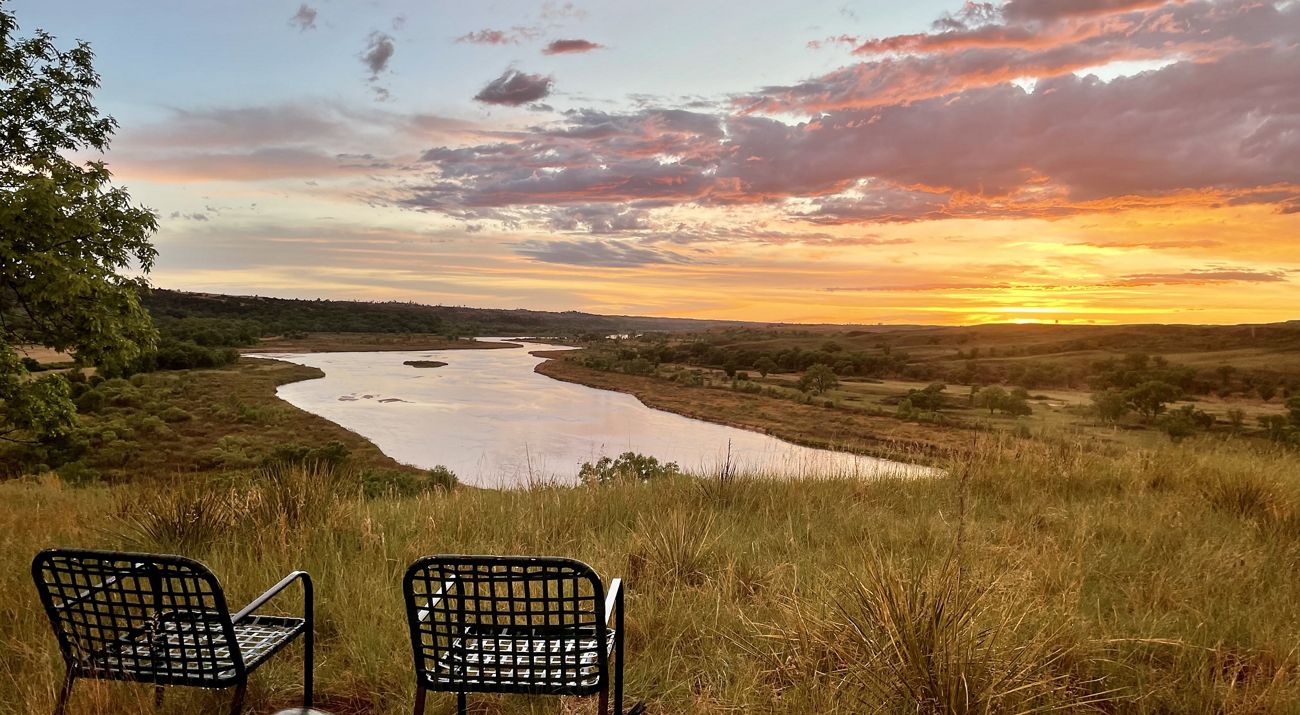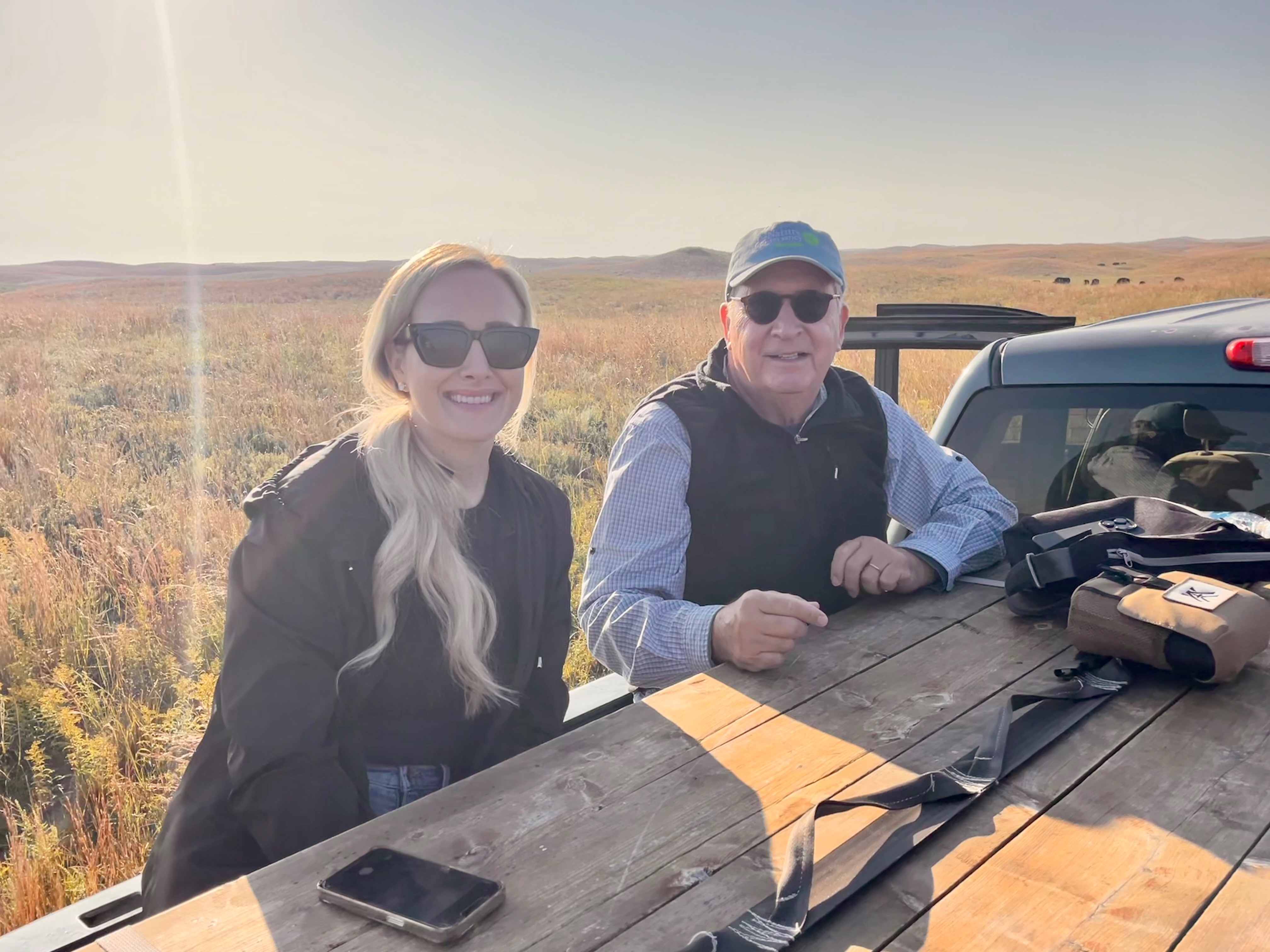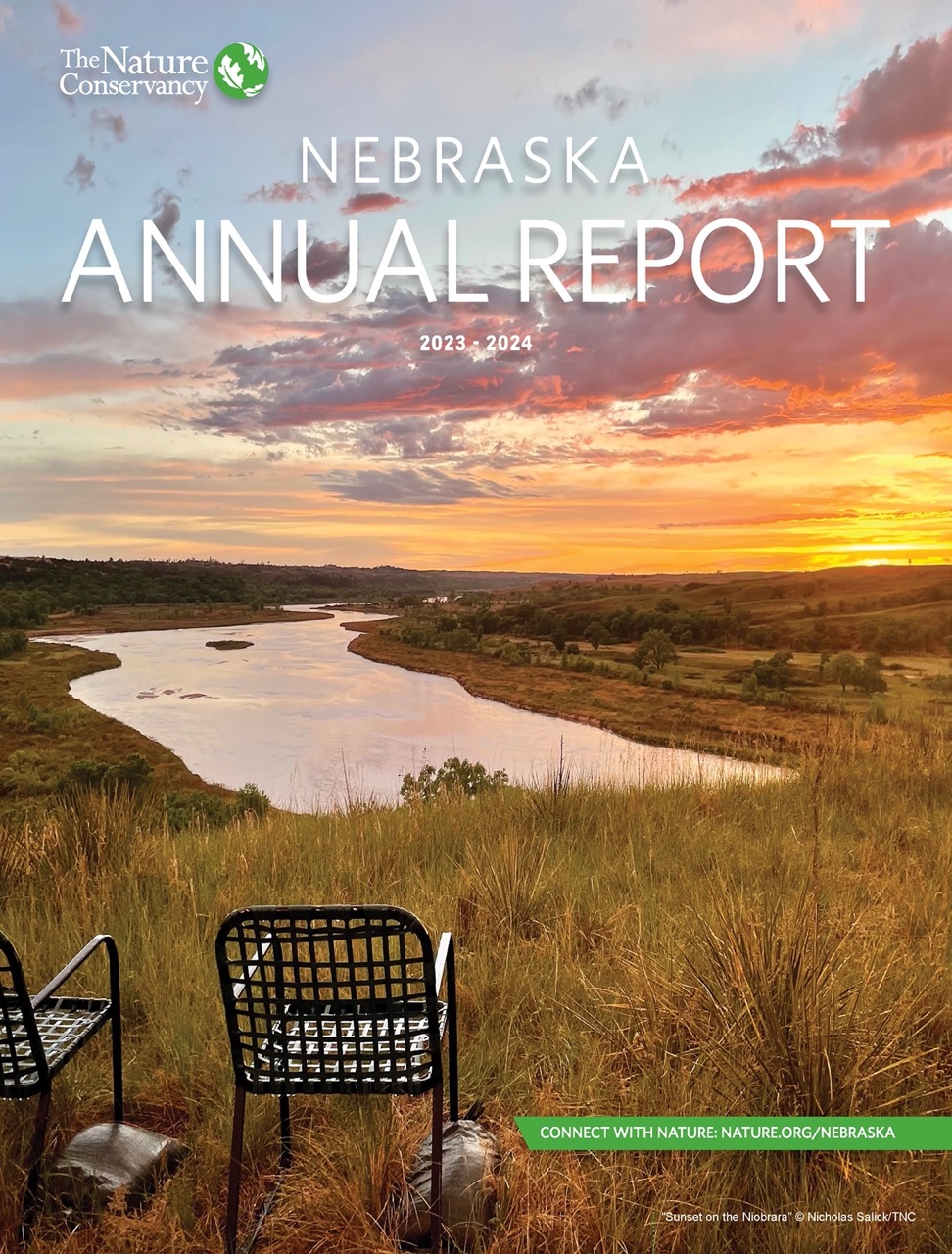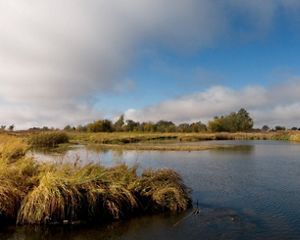2024 Nebraska Annual Report
Explore the year’s conservation successes with state director John Cougher.
Dear Friends,
Together, we find a way.
That’s The Nature Conservancy’s slogan for our “One Future” campaign for conservation. A livable climate, healthy communities and thriving nature: this is the one future The Nature Conservancy envisions.
How do we get to this future? The only way forward is together.
Together, we are celebrating ten years of our work with farmers to make row crop agriculture more sustainable. As you’ll see below, Nebraska is part of TNC’s larger effort to engage producers and communities to accelerate food production practices that improve the health of land and water.
Together, we are forging greater relationships with Nebraska’s tribal nations, learning valuable Traditional Ecological Knowledge and sharing our resources. In this report, you’ll hear from Brandon Cobb, Nebraska’s Indigenous Partnerships Program Manager, whose work contributes to a global effort to transparently collaborate with Indigenous peoples whose lands encompass much of the world’s biodiversity and whose knowledge and leadership is essential to enduring conservation.
Together, we protect wildlife by buying strategic tracts of land. You’ll read about our latest Platte River acquisition, knitting together even more habitat in our prairie complex. TNC’s work has helped protect approximately 15 million acres of land in the United States, and we continue to add strategic tracts where they matter most, protecting natural areas at an unprecedented scale.
Together, we confront the climate crisis head on, working with communities and policymakers to ensure cleaner air and less vulnerability to flooding and heat waves. Our staff and Trustees here in Nebraska and across the nation are more engaged than ever to share the best available science and to create, implement, and advocate for policies that support healthy natural systems.
Together, we are deciding what kind of Nebraska we want to leave to our grandchildren. It is humbling to see the lists of donors, Legacy Club members, tributes and current and former Trustees – all of you who have raised your hand and said, “Someone should do something, and that someone is me.”
I am so grateful to be part of an organization doing ambitious, creative work across the globe, and Nebraska is on the leading edge so often. What we are doing together matters to us, and matters to the world. Thank you, thank you, thank you.
John Cougher, Nebraska State Director
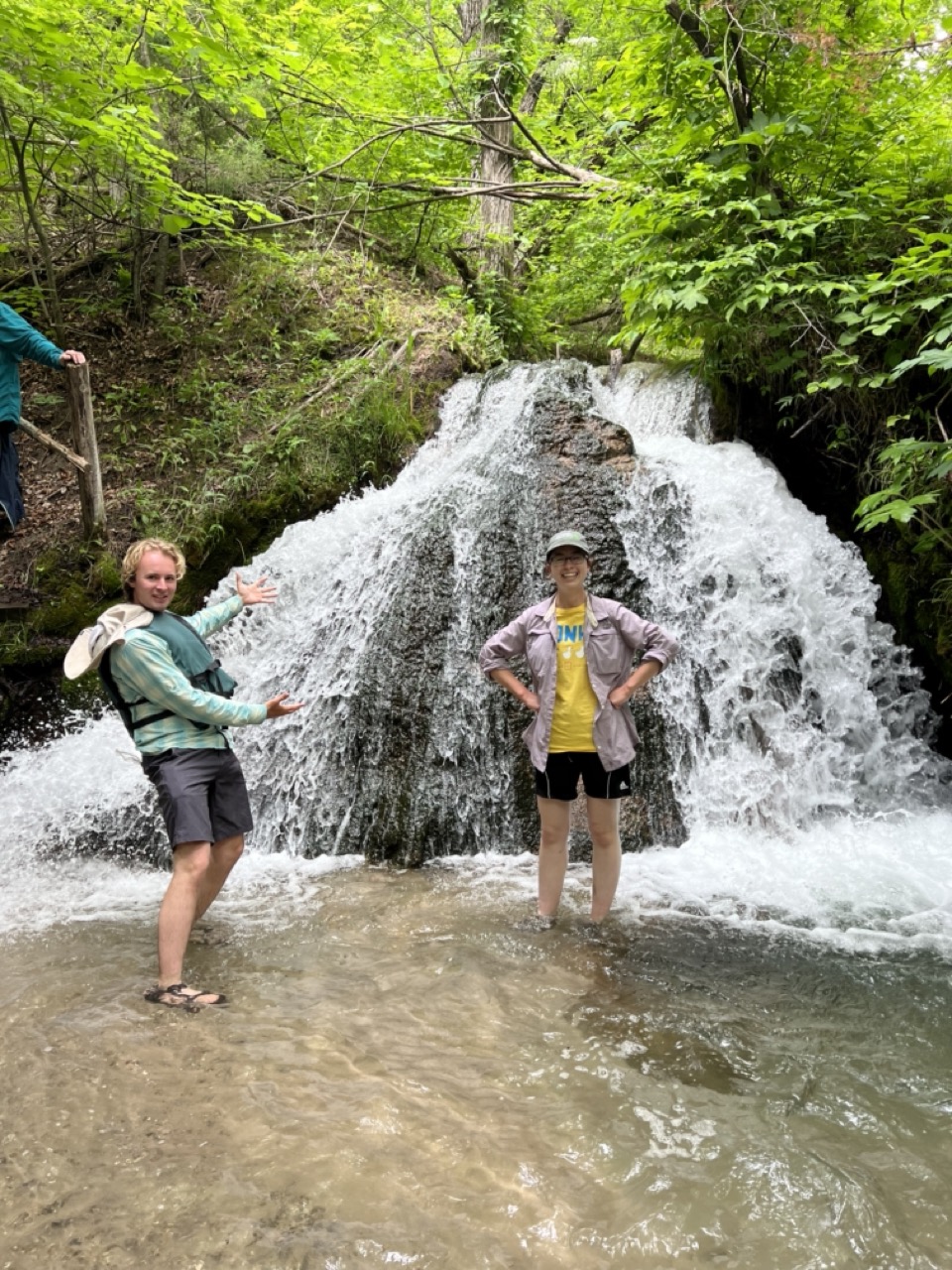
A Prairie Year: The 11th Class of Hubbard Fellows Shares Their Reflections
The Nature Conservancy is proud to host the Claire M. Hubbard Young Leaders in Conservation Fellowship Program – a one-year program for selected recent college graduates in conservation-related fields. It is designed to provide a comprehensive set of experiences working with a conservation organization and to bridge the gap between school and career. Fellows are housed at The Nature Conservancy’s Platte River Prairies Preserve in Wood River, Nebraska.
KEES HOOD SAYS: As the Fellowship draws to a close, the prairie resembles how it did when we arrived. The green grasses and flowers of every color of the rainbow have gone dormant, leaving the prairie a mottled brown. As other colors become scarce, you learn to appreciate how much variation exists in a dormant prairie – rusty reds, chocolate, straw yellow, ochre. Even the calls of sandhill cranes, the sound I most associate with my early months on the Platte, ring out again as migrating groups fly over on their journey south. I’ve spent time contemplating the Fellowship as fall turns steadily into winter.
The Fellowship has been a firehose of new information, places, and things. I’ve learned so many names, both those of plant and animal species and names of many different tools and techniques. How do you tell apart big bluestem from sand bluestem? What’s the difference between a UTV and an ATV? What do those acronyms mean? What’s patch-burn grazing? I’ve also had the pleasure of learning the names of so many people dedicated to conservation inside and outside Nebraska, both in TNC and our partners. When the right species, management tools, and people come together, you get this thing we call conservation.
Being a part of The Nature Conservancy has allowed me to understand just how much goes into conserving biodiversity in Nebraska and the world. I spent my pre-fellowship academic life learning the pieces of the puzzle – what each individual species is, the conditions they succeed in, whether something is native or nonnative – and using scientific techniques to find where pieces go. Even conservation at the smallest scale requires looking up from our quadrats and not just considering the wider biological context but also the social and economic systems around us as well – the table our puzzle is built on.
For better or for worse, everything is connected, and TNC’s efforts reflect this by working for biodiversity on many scales. As a Fellow, I’ve learned about high diversity restoration techniques that meticulously rebuild diversity on a few acres and TNC’s climate work preserving the atmosphere upon which all life depends.
I don’t know where I’m going next, but I do know I’ll be bringing what I’ve learned along the Platte with me. TNC Nebraska, our partners, and the prairie have been great teachers – and I want to put their lessons to good use.
CLAIRE MORRICAL SAYS: When I began the Hubbard Fellowship with a full year of learning ahead, I was thrilled. While my past internships were wonderful, their short duration was frustrating. You spend three months absorbing everything you can. And then, right when it feels like everything is clicking into place, your time is up.
But my GOODNESS, how much we’ve packed into a year! I’ve learned the plants and patterns of Platte River Prairies. I’ve scraped at the profiles of soils laid down hundreds of years ago. I’ve helped set the prairie ablaze and watched it reemerge verdant and unbothered. I can run a skid steer now!
Now it’s October. There are only three months left in the Fellowship and all I can think is, “Everything was just clicking into place. If only I could have one more year!” Apparently, learning is a lifelong process.
As it also turns out, when you experience a place intimately for a year – greeting cows in the morning, sipping tea in a bluestem sea, watching eyes glow in the grass at night—it tends to tether itself to your heart. I started this Fellowship feeling a little lost in the winter prairie, like moving into a neighborhood to find everyone gone on vacation. But I met the neighbors, visited their homes, and we took care of each other. Now as plants brown and winter creeps nearer, the prairie feels full of easy slumbering sighs, and it feels like home.
It’s hard to spend a full year on the Platte River Prairies and not feel how human it is. It’s an ecosystem that’s always collaborated with people. As we’ve spent time with Chris and Cody on the preserve, we’ve seen how their stewardship philosophies layer themselves over the landscape. Then you meet the staff who ensure we can continue stewarding our preserves and who bring them to others—people who have such a fierce love and hope for the prairies of TNC and of Nebraska. You meet volunteers and researchers who’ve found something specific that endeared them to our preserves—the butterflies, the pocket mice—and kept them coming back. Layers upon layers of perspective, creating something that is uniquely the result of this collective of individuals, human and non, like a really good baklava.
Looking to the next year, I can’t wait to meet new neighbors and create new tethers, like the ones that tied me to Nebraska’s prairies and people.
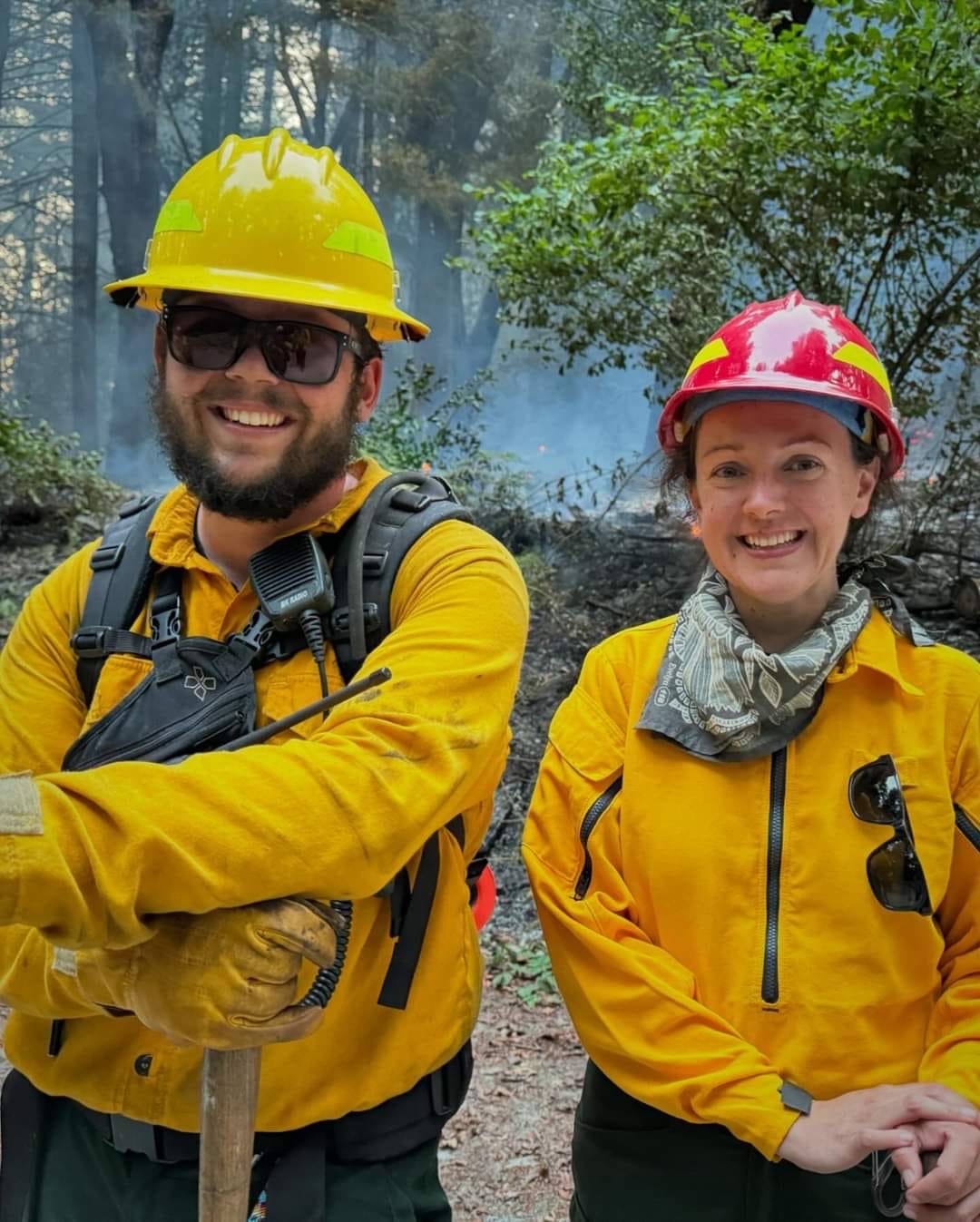
Five Questions With Brandon Cobb
Writer Jill Wells sat down with Brandon, TNC’s Indigenous Partnerships Program Manager and citizen of the Cherokee Nation, to talk about his work in Nebraska and beyond.
How do you describe your role at TNC?
I would describe my role as being a resource, both to our tribal partners but also to other TNC staff. Ultimately, I work on behalf of our tribal partners, supporting their goals and ambitions in whatever way I/TNC can. It’s a job that constantly has me thinking about new ideas and ways of working. I split my time between the field and the office, being available for on-the-ground support but also being a resource for planning, funding and brainstorming.
How did you get interested in Indigenous conservation?
I think I knew I would end up working with either my Tribe or Indigenous communities at some point, but it was my independent project of hosting the Nebraska Intertribal Conservation Summit as a Hubbard Fellow that solidified my commitment to working in Indigenous-led conservation. The summit brought my two worlds together in one event; all the environmental education I had received in college combined with my lived experience and desire to do good in Indian Country really made me feel like this is what I needed to be doing and where I fit. The summit proved that as a chapter, we were ready to be good partners and I’m happy to say that since then, I think we’ve done exactly that.
Tell us about your role in prescribed fire.
I split off a quarter of my time to work with TNC’s Indigenous Peoples Burning Network (IPBN). As a team member of the IPBN, I help support the connection of Indigenous cultural fire practitioners across the U.S. and spend time training myself in both cultural fire and fire suppression. This training allows me to be supportive of the fire objectives of our tribal partners here in Nebraska along with being able to support the fire programs at our preserves.
What’s been one of the highlights of the last year?
One of the biggest highlights of this last year has been seeing our tribal relationships grow beyond the “strictly business” phase. Being invited into cultural spaces, getting calls just to catch up and brainstorm, hearing the good and the bads, it’s really made me feel like we’ve gone beyond what one might expect out of a working relationship with a large organization like The Nature Conservancy. The work happening on the ground is great and can always serve as a highlight, but feeling like we’re welcomed into the work in a greater way signals to me that we’ve built sustainability into the program and will continue to achieve those on-the-ground impacts even through shifting winds. When so many other organizations and agencies struggle to even build a sustainable relationship, feeling like we’ve achieved that here makes me incredibly proud of our team.
How do you see the Nebraska program strengthening our relationships with Tribal Nations in the year ahead?
In many ways, I think the best way to strengthen our relationships and the Nebraska program as a whole is just to keep doing what we’re doing. We’ve developed a model here of what it looks like to work in right relations, and while that model is never rigid and no one tribe is the same as the next, we’re showing that with a foundation of care and consideration towards our partners, we can show up and support them in new and unique ways. So much of how we operate our Nebraska program is by letting our partners sit in the driver’s seat, and that allows us the opportunity to be better listeners and better supporters of the work and projects identified.
Special thanks to the Mammel Family Foundation and the Sherwood Foundation for supporting Brandon’s work.
Welcome to the Lehmann Tract
New Acquisition adds to Platte River Prairies Complex
The Nature Conservancy has acquired the 240.6-acre Lehmann tract, located in Hall County, for $1,625,000.
This purchase adds 40 acres of grassland adjacent to the Platte River Prairies Preserve (see map). An additional 200 acres of cropland provide a buffer to the protected lands. TNC will manage the grasslands as part of the conservation complex; they will provide stream buffer habitat for several conservation targets, including sandhill crane roosting habitat and several native prairie communities. TNC will implement regenerative practices on the row crop portion of the tract to minimize water and fertilizer use and impacts to water quality.
“The conservation benefits of the Lehmann tract acquisition will expand beyond the property itself by increasing connectivity of critical habitat, and by complementing conservation holdings—ours and our partners—along this part of the Platte River,” said John Cougher, State Director.
The land is part of the main spring stopover habitat for the midcontinent population of sandhill cranes and for the highly endangered migratory whooping cranes. These species use grasslands and crop lands within the river valley as important feeding and loafing habitats.
“This property also shares a greater prairie chicken lek with our current TNC land adjacent to it,” said Chris Helzer, Director of Science. “There is a group of prairie chickens that displays along the border between our current land and the Lehmann tract. Sometimes they’re on our grassland, sometimes they’re on the Lehmann tract. It’s just one more reason we want to ensure this piece of ground stays open.”
The priority at the Platte River Prairies Preserve is to prevent wet meadows and grasslands from being converted into other uses that would diminish their ability to store soil carbon (a natural climate solution). Creating and sustaining habitat heterogeneity and sustaining species diversity maintains ecological resilience, which helps mitigate the impacts of climate change.
“We are still fundraising for this acquisition, but know that protecting land through ownership is something many of our members are passionate about,” said Sara McClure, Director of Development. “Anyone interested in supporting this habitat work is invited to call me at (402) 342-0282 x 2.”

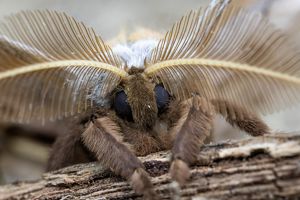
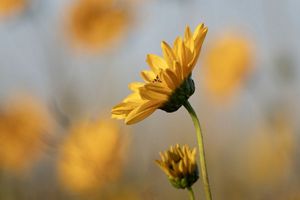
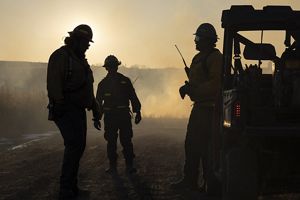
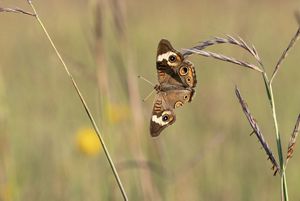
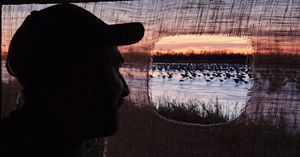
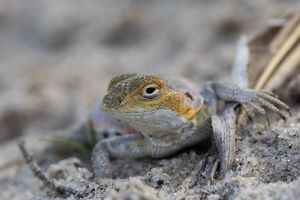

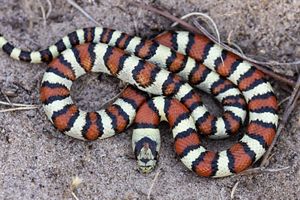
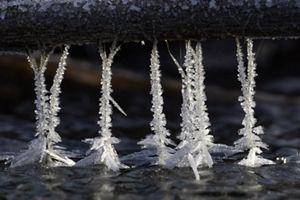
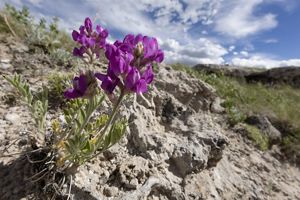

Polyphemus moth (male): The Nature Conservancy's Niobrara Valley Preserve. © Chris Helzer

Seeking the sun: Stiff sunflower (Helianthus pauciflorus). The Nature Conservancy's Platte River Prairies - Miller Tract. Nebraska. © Chris Helzer

Fire crew at sunset: Prescribed fire at The Nature Conservancy's Niobrara Valley Preserve, Nebraska. © Chris Helzer

Buckeye butterfly: The Nature Conservancy's Platte River Prairies - Miller Tract. Nebraska. © Chris Helzer

Cranes on the Platte River: Watching migratory sandhill cranes come into their evening roost on the Platte River in the evening. The Nature Conservancy's Platte River Prairies, Nebraska © Chris Helzer

Lesser earless lizard: The Nature Conservancy's Niobrara Valley Preserve, Nebraska © Chris Helzer

Bison on the prairie: Bison calf and mama at the Niobrara Valley Preserve. © Chris Helzer

Milk snake at Niobrara Valley: Milk snake after sunset. The Nature Conservancy's Niobrara Valley Preserve, Nebraska © Chris Helzer

Frost and Ice: Frost and ice at the Derr Sandpit Wetland Restoration. The Nature Conservancy's Platte River Prairies, Nebraska. © Chris Helzer

Wooly locoweed: Wooly locoweed (Oxytropis lambertii). The Nature Conservancy's Cherry Ranch, Nebraska Panhandle. © Chris Helzer
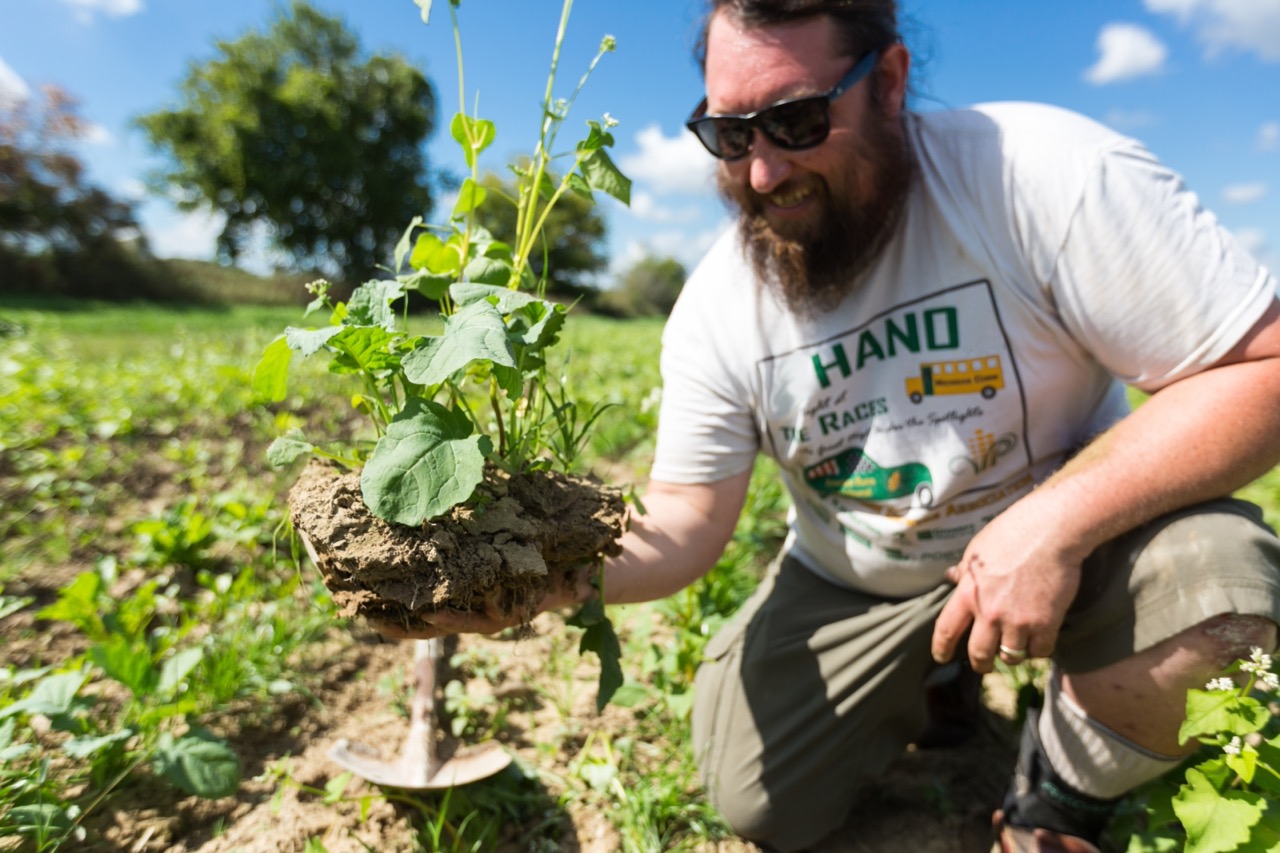
Farming the Blue River
Across the state of Nebraska, nitrate concentrations are found in excess of EPA drinking water standards in over a third of groundwater wells. Freshwater ecosystems in the eastern third of the state experience seasonal toxic algae blooms that shut down beaches and kill freshwater life.
The primary source of that nitrogen? Excess fertilizer from agricultural lands that leaches and runs off into ground and surface water.
Abating this freshwater nitrogen pollution improves the wellbeing of human and nonhuman life alike in Nebraska and beyond. To reduce freshwater nutrient pollution, TNC is teaming up with farmers to implement nutrient management practices.
The Farming for the Blue River pilot project geography falls within the Lower Big Blue River watershed, which includes nearly two million acres of cropland in southeast Nebraska. This region is a hotspot for nitrate contamination in the state.
In this pilot project, TNC is working with 30 farmers on 4,800 acres to implement a suite of nutrient management practices. “These practices can reduce nitrogen pollution to freshwater ecosystems and improve farm economics without requiring major changes to a farmer’s row crop operation,” said Jacob Fritton, Director of Agriculture. With support, project farmers can fine tune the amount, time, type and placement of nitrogen fertilizer application to meet crop needs more precisely.
The thirty farmers who enroll in the project will receive a combination of Natural Resources Conservation Service (NRCS) and project-specific technical and financial assistance over three years to implement new nutrient management practices on 160 acres (i.e., one nonirrigated quarter-section-sized field) on their operations. TNC is engaging enrolled farmers to 1) work with project leads and local NRCS staff to clarify their nutrient management goals (including risks to avoid); 2) co-create a new nutrient management regimen that aligns with the best available science, NRCS practice codes and the realities of their operations; 3) support farmers as they apply for Farm Bill funding; 4) receive $10 per-acre landowner incentive funds from TNC; 5) provide feedback and data to TNC project leads; and 6) participate in educational events.
One such practice is cover crop adoption. Cover crops can reduce nutrient runoff by immobilizing nutrients in their roots during the non-cropping season and through direct nitrogen fixation, which reduces fertilizer input needs. By integrating cover crops explicitly into project farmers’ nutrient management regimen, we can quantify the water quality and financial benefits of this increasingly popular regenerative agriculture practice.
From Rhode Island With Love: Meet Walter Bopp
Sometimes you find a place that speaks to you. For Walter Bopp, the Sandhills is such a place.
Walter grew up in the New York City area, where he made a career as an investment banker with Morgan Stanley. He raised three (now grown) daughters to explore and enjoy nature just as he did, playing in Central Park, exploring Connecticut forests and visiting the New York Botanical Garden.
These days, Walter has been making his way around the globe.
In 2010, on a trip from New York to Los Angeles to visit his daughter, he decided to break up his travel with a journey to someplace he’d never beenand he landed on Nebraska. “I landed in Denver and headed for Nebraska,” Bopp said. “I ended up in a place called Brule. I decided to drive to Cherry County, because I recalled reading in a National Geographic magazine as a kid that it was the largest county in Nebraska, and there was only one stoplight. As a city kid, it might as well have been the moon.”
Walter became fascinated as he drove through the Sandhills. Once he made his way to Valentine, he discovered the Niobrara River and Fort Niobrara National Wildlife Refuge and he was hooked. “I was entranced with the six ecosystems that come together there,” he said.
Fourteen years later, Walter has been back to Nebraska a whopping nine times, including visits to TNC’s Niobrara Valley Preserve. He’s brought his wife and most recently a daughter, Lillian (a Ph.D. candidate in forensic psychology at UNL) to see the river with him. “I’m glad that it all came together,” he said. “We got to tour the Preserve on picnic tables in the back of a pickup, which is a really cool way to get around. The buffalo are interesting. We kayaked the river and we were by ourselves the whole time.”
Walter cares deeply about water and water issues. “A touchpoint for me is the Ogallala Aquifer and its protection,” he said.
Conservation of Nebraska’s Sandhills recently inspired Walter to make a generous gift to the Niobrara Valley Preserve. He worked with Development Officer Nic Salick, who says “Walter is more well-traveled in Nebraska than most Nebraskans.”
Walter has driven the length of Highway 2 from Alliance, visited Niobrara State Park, Scottsbluff, Red Cloud ... he’s seen the cranes on the Platte River and Toadstool Geologic Park.
“I think what TNC is doing is wonderful,” he said. “The protection of the Niobrara Riveras a Scenic River and the Sandhills is important. One of my great thrills is when I get off the road in South Dakota and start heading south. When I see the big ‘welcome to Nebraska!’ sign I stop and take that in and smile.”

Stay in the Know!
Sign up to receive our monthly Nature News email.
Download
There’s more to explore — including a comprehensive list of our generous donors and supporters! Take a look at the full report here.
DOWNLOADMake a Difference in Nebraska
The Nature Conservancy's mission is to preserve plants, animals and natural communities that represent the diversity of life on Earth by protecting the lands and waters they need to survive. We’ve been working in Nebraska to do just that.
